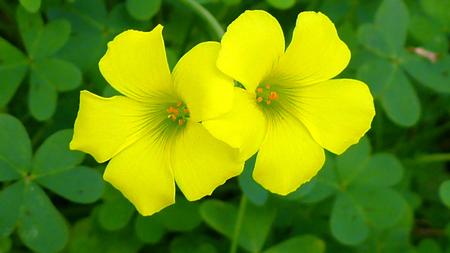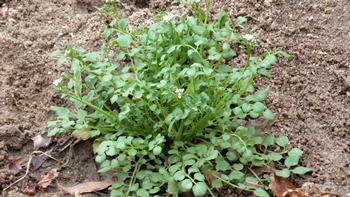News from the Edible Demo Garden
April 2021: Controlling Weeds

Weed Control for Annuals: Get them before they Pop
Annual weeds sprout from seeds, grow for one year, and then die. An example of an annual in our garden this spring is Hairy Bittercress, a beautiful plant that has edible spicy leaves. It reproduces by flowering and then forming a pod that pops open explosively to fling its seeds around your garden. So to overcome this weed as well as other annual weeds, you need to prevent pod production by removing weeds when they are young before they set seed.

‘Water, Wait, then Cultivate’
A second strategy goes after those hidden seed reserves in the soil. It is ‘water, wait, then cultivate’. This can eliminate up to 95% of the weed seed population for a season. Clear an area of all weeds; then water or wait for a shower to germinate hidden weed seeds. After most have germinated, spade them out of the soil and remove. Then water a second time. Repeat the spading and removal. This process will get rid of most of the weed seeds in the top ½ inch of soil where germination largely occurs.
Weed Control for Perennials
Perennial weeds are not as simple to control. They live longer than 1 to 2 years and some have large root systems in addition to flowering. Dandelions are simple perennials that reproduce by seed only. But there are creeping perennials like woodsorrel (Oxalis) that flower and make seeds and also have underground root systems (stolons, rhizomes, tubers, bulbs). So the objective for these more complicated weeds is to destroy the underground reproductive organs because the weed will grow back even when you remove the plant before seeds set. But if you maintain vigilance and remove the plant faithfully, eventually the underground root systems will be starved for food and will die. You have shut down photosynthesis, the process that makes food for the plant. This practice takes more than one year to see results but your patience will pay off down the road.
The Magic of Mulch
The last step to reducing this yearly weed onslaught is to employ the magic of mulch. Mulch blocks the sunlight needed for weed seeds to germinate and underground root systems to reproduce. It prevents weeds from reaching sunlight, thus shutting down photosynthesis. Keep in mind that the coarser the material used, the deeper the mulch needs to be. Use 1 to 3 inches for finer materials like grass clippings and 3 to 6 inches for coarser materials like straw or chunky bark.
Have your toolbox ready for next spring’s unwelcome guests, apply these strategies and you will be on your way to having more freedom to sit back and enjoy our glorious springtime.
More information on weeds.
